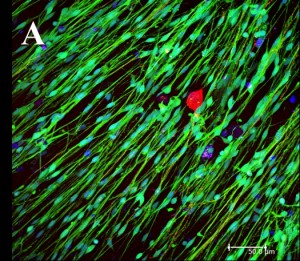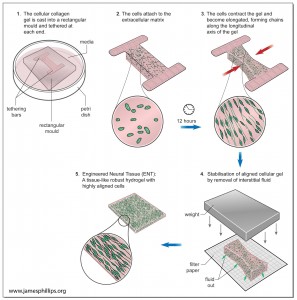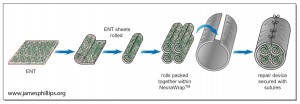Nervous system repair
Repair devices are designed to encourage growth of host neurons through an area of damage. They don’t contain any neurons, but often include aligned materials and glial cells in order to guide and support regenerating neurons. They need to be made from materials and cells suitable for safe therapeutic use, and as well as promoting neuronal growth they must restore the biomechanical functionality of the tissue.
Engineered Neural Tissue for nervous system repair
Engineered neural tissue (EngNT) mimics key features of cellular and extracellular nervous system components. Rather than culturing cells within artificial biomaterial scaffolds, glial cells are maintained within a natural extracellular matrix hydrogel. Careful control of their mechanical environment causes the glial cells to align (using the same principles described for aligned tissue models), then plastic compression is used to stabilise the aligned tissues.
The result is a robust hydrogel material packed with highly aligned glial cells that can support and guide neuronal regeneration (see Georgiou et al., 2013 and Phillips 2014).

A flat sheet of Engineered Neural Tissue contains aligned glial cells (green) that support and guide neuronal regeneration
Sheets of this versatile cellular biomaterial can be rolled into fibres and packed together to form a stable repair conduit.
Repair devices fabricated in this way can be tailored towards repair of specific parts of the nervous system. This involves selecting the appropriate glial cell type and adapting the extracellular matrix components to ensure integration of the implant and support of neuronal regeneration.
This technology has undergone significant development towards clinical translation, particularly for the repair of peripheral nerves. A variety of potential therapeutic cell options have been explored using:
These can mimic the behaviour of Schwann cells that are naturally found in peripheral nerve grafts.
Other studies have investigated the material component of the EngNT and identified approaches for storage and transport of the cellular materials. Ongoing academic projects are exploring new options for both the cell and the material components, and clinical translation of EngNT technology is being conducted in collaboration with the UCL spin-out company Glialign Ltd.

